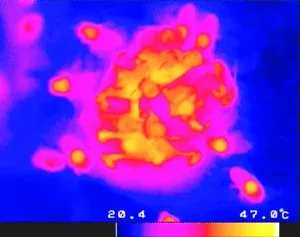Bizarre Bee-havior in the Battle Against the Giant Hornet
To protect their hive from an invading hornet, Asian honeybees gang up and surround it, forming a “hot defensive bee ball”
/https://tf-cmsv2-smithsonianmag-media.s3.amazonaws.com/filer/20120319122036bees-web.jpg)
For millions of years, Japanese honeybees have been locked in a deadly battle with the Japanese giant hornet, a fierce predator with an appetite for bee larvae. With a two-inch-long body and a 3-inch wingspan, the hornet is enormous – many times larger than the bees. But the honeybees have evolved a unique defense mechanism: When a hornet invades a honeybee hive, as many as 500 bees gang up and form a tight ball around the attacker. The heat from the bees’ vibrating wings and the carbon dioxide they respire proves a deadly combination. In less than an hour, the hornet is dead.
The attack unfolds like this: When a hornet approaches a honeybee hive, bee guards posted at the entrance fiercely shake their abdomens. In a paper published last month, researchers argue that this abdomen shaking represents an “I see you” signal, something that is advantageous to both predator and prey. “The prey avoids attack, the predator avoids chasing a prey that has been alerted,” the researchers write. If the waggling doesn’t deter the hornet, the guards alert the rest of the hive. Some of the worker bees exit the nest and wait outside. If the hornet moves to attack, these bees surround it, forming a “hot defensive bee ball.”

A new study, published last week, examines what goes on in the honeybees’ brains while they are in this ball. The researchers, including Takeo Kubo of the University of Tokyo and Masato Ono of Tamagawa University, first identified a gene whose expression could be used as a marker of brain activity. They then used a live hornet tied to a wire to spur the formation of a bee ball. When they inserted the hornet into the hive, the bees swarmed and the researchers managed to extract the bee ball and place it in a beaker. That enabled them to pluck individual bees from the pile at different time points and examine their brains for increased expression of the target gene. (See a video of the process here.)
The balling behavior seemed to prompt activity in particular neurons found in bee brain regions called the mushroom bodies, which are involved in learning and memory. Heat exposure alone led to increased activity in these same neurons. What this means isn’t yet entirely clear. The researchers speculate these neurons may help the bees monitor how hot the ball gets and avoid overheating.
One thing is clear: The balling behavior seems vital to the bees’ survival. European honeybees, which were introduced in Japan more than a century ago, have not evolved any defense mechanisms against giant hornets. Hornet attacks can devastate their hives; a group of 20 to 30 hornets can slaughter a 30,000-bee colony in just a few hours.